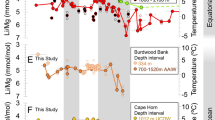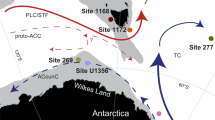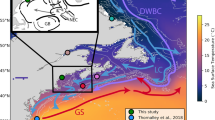Abstract
Relative to the present day, meridional temperature gradients in the Early Eocene age (∼56–53 Myr ago) were unusually low, with slightly warmer equatorial regions1 but with much warmer subtropical Arctic2 and mid-latitude3 climates. By the end of the Eocene epoch (∼34 Myr ago), the first major Antarctic ice sheets had appeared4,5, suggesting that major cooling had taken place. Yet the global transition into this icehouse climate remains poorly constrained, as only a few temperature records are available portraying the Cenozoic climatic evolution of the high southern latitudes. Here we present a uniquely continuous and chronostratigraphically well-calibrated TEX86 record of sea surface temperature (SST) from an ocean sediment core in the East Tasman Plateau (palaeolatitude ∼65° S). We show that southwest Pacific SSTs rose above present-day tropical values (to ∼34 °C) during the Early Eocene age (∼53 Myr ago) and had gradually decreased to about 21 °C by the early Late Eocene age (∼36 Myr ago). Our results imply that there was almost no latitudinal SST gradient between subequatorial and subpolar regions during the Early Eocene age (55–50 Myr ago). Thereafter, the latitudinal gradient markedly increased. In theory, if Eocene cooling was largely driven by a decrease in atmospheric greenhouse gas concentration6, additional processes are required to explain the relative stability of tropical SSTs given that there was more significant cooling at higher latitudes.
This is a preview of subscription content, access via your institution
Access options
Subscribe to this journal
Receive 51 print issues and online access
$199.00 per year
only $3.90 per issue
Buy this article
- Purchase on Springer Link
- Instant access to full article PDF
Prices may be subject to local taxes which are calculated during checkout



Similar content being viewed by others
References
Pearson, P. N. et al. Stable tropical climate through the Eocene epoch. Geology 35, 211–214 (2007)
Sluijs, A. et al. Arctic late Paleocene–early Eocene paleoenvironments with special emphasis on the Paleocene-Eocene thermal maximum (Lomonosov Ridge, Integrated Ocean Drilling Program Expedition 302). Paleoceanography 23 10.1029/2007PA001495 (2008)
Sluijs, A. et al. Environmental precursors to rapid light carbon injection at the Palaeocene/Eocene boundary. Nature 450, 1218–1221 (2007)
Zachos, J. C., Breza, J. R. & Wise, S. W. Early Oligocene ice sheet expansion on Antarctica: stable isotope and sedimentological evidence from Kerguelen Plateau, Southern Indian Ocean. Geology 20, 569–573 (1992)
Barker, P. F., Dieckmann, B. & Escutia, C. Onset of Cenozoic Antarctic glaciation. Deep-Sea Res. II 54, 2293–2307 (2007)
Zachos, J. C., Dickens, G. R. & Zeebe, R. E. An early Cenozoic perspective on greenhouse warming and carbon-cycle dynamics. Nature 451, 279–283 (2008)
Schouten, S., Hopmans, E. C., Schefuß, E. & Sinninghe Damsté, J. S. Distributional variations in marine crenarchaeotal membrane lipids: a new tool for reconstructing ancient sea water temperatures? Earth Planet. Sci. Lett. 204, 265–274 (2002)
Müller, P. J., Kirst, G., Rohland, G., von Storch, I. & Rosell-Melé, A. Calibration of the alkenone paleotemperature index UK'37 based on core-tops from the eastern South Atlantic and the global ocean (60°N-60°S). Geochim. Cosmochim. Acta 62, 1757–1772 (1998)
Liu, Z. et al. Global cooling during the Eocene-Oligocene climate transition. Science 323, 1187–1190 (2009)
Exon, N., Kennett, J. P. & Malone, M. The Cenozoic Southern Ocean: Tectonics, Sedimentation, and Climate Change between Australia and Antarctica (Geophys. Monogr. Ser. 151, American Geophysical Union, 2004)
Stickley, C. E. et al. in Proc. Ocean Drilling Program, Scientific Results (eds Exon, N. F., Kennett, J. P. & Malone, M. J.) 1–57 (2004)
Huber, M. et al. Eocene circulation of the Southern Ocean: was Antarctica kept warm by subtropical waters? Paleoceanography 19 10.1029/2004PA001014 (2004)
Stickley, C. E. et al. Timing and nature of the deepening of the Tasmanian Gateway. Paleoceanography 19 10.1029/2004PA001022 (2004)
Bohaty, S. M. & Zachos, J. C. Significant Southern Ocean warming event in the late Middle Eocene. Geology 31, 1017–1020 (2003)
Hollis, C. J. et al. Tropical sea temperatures in the high latitude South Pacific during the Eocene. Geology 37, 99–102 (2009)
Burgess, C. E. et al. Middle Eocene climate cyclicity in the southern Pacific: implications for global ice volume. Geology 36, 651–654 (2008)
Thomas, D. J., Bralower, T. J. & Jones, C. E. Neodymium isotopic reconstruction of the Late Paleocene - Early Eocene thermohaline circulation. Earth Planet. Sci. Lett. 209, 309–322 (2003)
Ivany, L. C. et al. Eocene climate record of a high southern latitude continental shelf: Seymour Island, Antarctica. Geol. Soc. Am. Bull. 120, 659–678 (2008)
Barron, E. J. Eocene equator-to-pole surface ocean temperatures: a significant climate problem? Paleoceanography 2, 729–739 (1987)
Schrag, D. P., DePaolo, D. J. & Richter, F. M. Reconstructing past sea surface temperatures: correcting for diagenesis of bulk marine carbonate. Geochim. Cosmochim. Acta 59, 2265–2278 (1995)
Pearson, P. N. et al. Warm tropical sea surface temperatures in the Late Cretaceous and Eocene epochs. Nature 413, 481–487 (2001)
Huber, M. A hotter greenhouse? Science 321, 353–354 (2008)
Greenwood, D. R. & Wing, S. L. Eocene continental climates and latitudinal temperature gradients. Geology 23, 1044–1048 (1995)
Huber, M. & Sloan, L. C. Heat transport, deep waters, and thermal gradients: coupled simulation of an Eocene ‘greenhouse’ climate. Geophys. Res. Lett. 28, 3481–3484 (2001)
Abbot, D. S. & Tziperman, E. Sea ice, high-latitude convection, and equable climates. Geophys. Res. Lett. 35 10.1029/2007GL032286 (2008)
Hay, W. W. et al. Alternative global Cretaceous paleogeography. Spec. Pap. Geol. Soc. Am. 332, 1–47 (1999)
Röhl, U. et al. in The Cenozoic Southern Ocean: Tectonics, Sedimentation, and Climate Change Between Australia and Antarctica (eds Exon, N., Kennett, J. P. & Malone, M.) 127–151 (Geophys. Monogr. Ser. 151, American Geophysical Union, 2004)
Sangiorgi, F. et al. Cyclicity in the middle Eocene central Arctic Ocean sediment record: orbital forcing and environmental response. Paleoceanography 23 10.1029/2007PA001487 (2008)
Weller, P. & Stein, R. Paleogene biomarker records from the central Arctic Ocean (Integrated Ocean Drilling Program Expedition 302): organic carbon sources, anoxia, and sea surface temperature. Paleoceanography 23 10.1029/2007PA001472 (2008)
Shea, D. J., Trenberth, K. E. & Reynolds, R. W. A global monthly sea surface temperature climatology. J. Clim. 5, 987–1001 (1992)
Acknowledgements
Funding for this research was provided by Utrecht University, the Netherlands Organisation for Scientific Research (VICI grant to S.S.; VENI grant to A.S.) and the LPP Foundation. This research used samples and data provided by the Ocean Drilling Program (ODP). The ODP was sponsored by the US National Science Foundation and participating countries under the management of Joint Oceanographic Institutions, Inc. G. Nobbe, E. van Bentum, E. Speelman, J. Ossebaar, A. Mets and E. Hopmans are thanked for technical support. We acknowledge C. J. Hollis, P. N. Pearson and P. F. Sexton for providing published data. A. J. P. (Sander) Houben, P. N. Pearson and M. Huber are thanked for critical comments.
Author Contributions P.K.B., S.S., H.B. and A.S. designed the research, P.K.B and S.S. performed the organic geochemical analyses; P.K.B. updated the age model for ODP Site 1172 and performed the data compilations. All authors contributed to interpreting the data and writing the paper.
Author information
Authors and Affiliations
Corresponding author
Supplementary information
Supplementary Information
This file contains Supplementary Notes, Supplementary Figures S1-S4 with Legends, Supplementary Table 1, Supplementary Methods and Data and Supplementary References. (PDF 1422 kb)
Supplementary Data
This table shows TEX86 index values and SST reconstructions for ODP Site 1172 in depth (mbsf) and age (Myrs ago). (XLS 41 kb)
Rights and permissions
About this article
Cite this article
Bijl, P., Schouten, S., Sluijs, A. et al. Early Palaeogene temperature evolution of the southwest Pacific Ocean. Nature 461, 776–779 (2009). https://doi.org/10.1038/nature08399
Received:
Accepted:
Issue Date:
DOI: https://doi.org/10.1038/nature08399
This article is cited by
-
Short-term middle Eocene (Bartonian) paleoenvironmental changes in the sedimentary succession of Olivetta San Michele (NW Italy): the response of shallow-water biota to climate in NW Tethys
Facies (2024)
-
Early Paleogene precipitation patterns over East Asia: Was there a monsoon after all?
Palaeobiodiversity and Palaeoenvironments (2024)
-
The rise of predation in Jurassic lampreys
Nature Communications (2023)
-
Warm deep-sea temperatures across Eocene Thermal Maximum 2 from clumped isotope thermometry
Communications Earth & Environment (2022)
-
Enhanced ocean oxygenation during Cenozoic warm periods
Nature (2022)
Comments
By submitting a comment you agree to abide by our Terms and Community Guidelines. If you find something abusive or that does not comply with our terms or guidelines please flag it as inappropriate.



